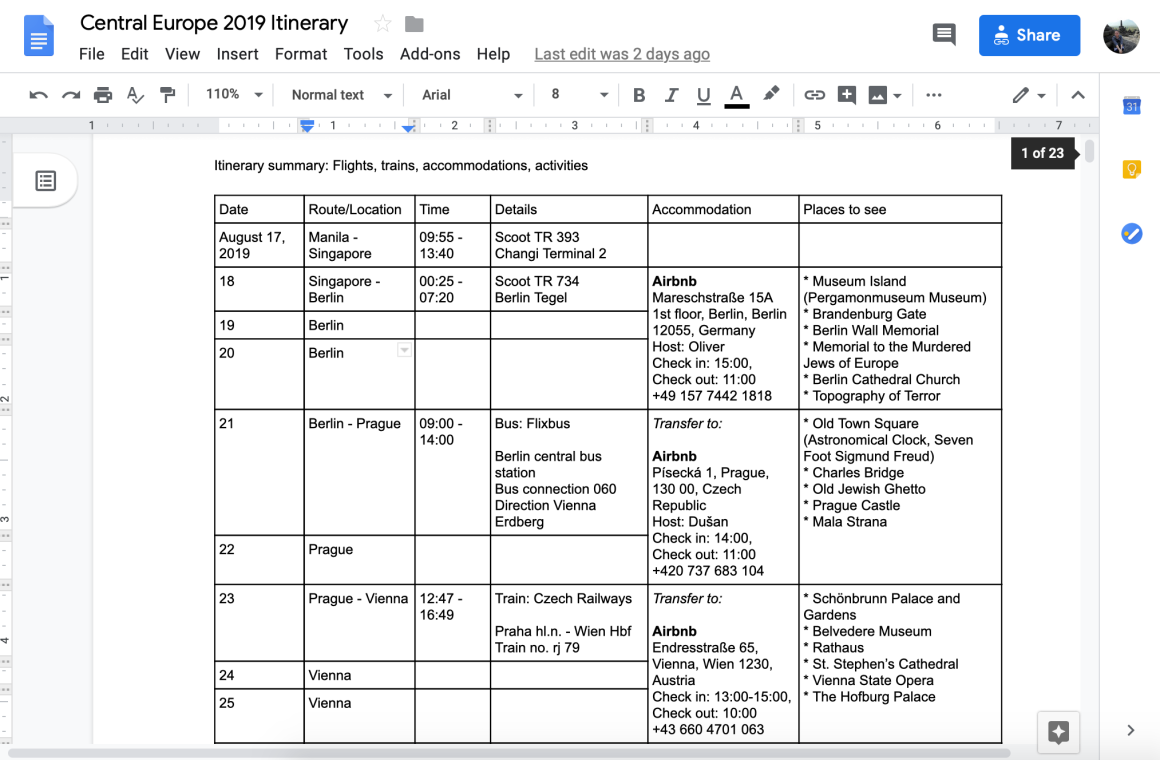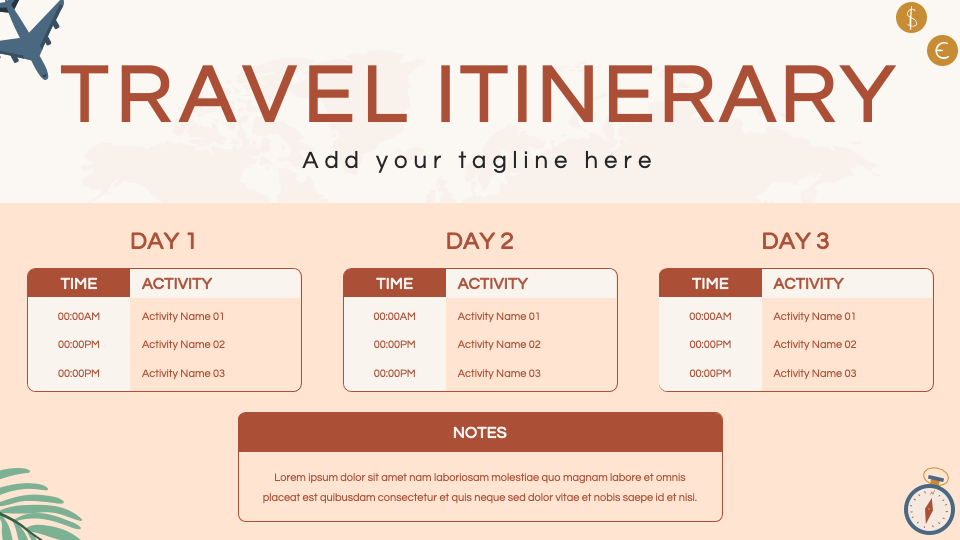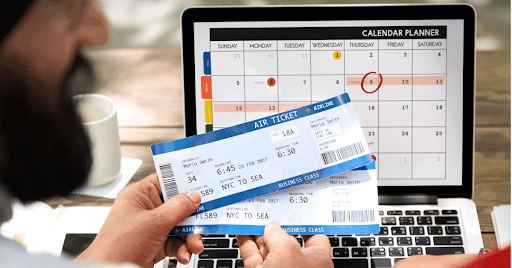What is a travel itinerary? Simply put, a travel itinerary is a detailed plan that outlines the key elements of your trip, including transportation, accommodation, activities, and important travel information. It acts as a personal travel schedule—helping you stay organized, on time, and fully prepared for every part of your journey.
A typical travel itinerary includes your flight details, hotel check-in and check-out times, transportation arrangements, and a day-by-day breakdown of your planned activities.
It may also include reservation numbers, addresses, emergency contacts, and important notes like local time zones or dress codes. Whether you’re traveling for business or pleasure, having all of this information in one place can save you time and reduce stress.
There are different formats and styles of itineraries depending on your needs. A leisure travel itinerary might focus on sightseeing, dining, and entertainment, while a business itinerary includes meetings, work events, and logistical details like venue addresses or Wi-Fi availability.
Some people prefer to build detailed hour-by-hour plans, while others opt for flexible outlines that allow more spontaneity.
Many travelers create their own itineraries using apps like Google Docs, Notion, or TripIt, while others rely on travel agencies or tour companies to provide professional, customized plans.
The biggest advantage of using a travel itinerary is efficiency. It helps ensure you don’t miss flights, forget reservations, or waste time figuring out what to do next. It also gives peace of mind, especially when visiting unfamiliar destinations.
What Does a Travel Itinerary Include?
A well-prepared travel itinerary includes all the essential details needed to keep your trip organized, smooth, and stress-free. Whether it’s a simple weekend getaway or a complex international tour, your itinerary acts as a central guide, outlining each step of your journey from start to finish.
At the core, a travel itinerary includes your transportation details—such as flight numbers, departure and arrival times, train or bus schedules, and rental car confirmations. It also lists accommodation information, including hotel names, check-in/check-out times, addresses, and reservation numbers.
Beyond logistics, a comprehensive itinerary features a day-by-day schedule of activities, like sightseeing tours, dining reservations, museum visits, or leisure time. Each day’s entry might include timing, ticket information, meeting points, and estimated travel time between locations. This helps maximize your time while ensuring you don’t miss anything important.
A good itinerary also includes important contact information, such as the numbers for your hotel, airline, tour guide, or emergency services. For international trips, travelers may include passport and visa details, currency exchange rates, local customs, and language tips to stay prepared.
Optional but helpful items include maps, weather forecasts, packing checklists, and budget tracking. For business travelers, the itinerary may also list meeting times, addresses, dress codes, or Wi-Fi availability.
Today, many travelers use digital tools and apps like TripIt or Google Docs to store and update their itineraries on the go. Others prefer printable versions for quick access.
In summary, a travel itinerary includes everything you need to navigate your trip confidently—from flights and hotels to daily activities and emergency contacts. It’s your personal roadmap, ensuring a well-structured, enjoyable, and worry-free travel experience.
Types of Travel Itineraries

Travel itineraries come in different types, each designed to match a specific kind of trip. Whether you’re heading out for business, a vacation, or a multi-country adventure, the right itinerary helps you stay organized and make the most of your time.
One of the most common types is the leisure travel itinerary. This is typically used for vacations and includes details like flights, hotel reservations, sightseeing schedules, restaurant bookings, and downtime. These itineraries help travelers balance activities with relaxation while making sure nothing important is missed.
Next is the business travel itinerary, which focuses more on efficiency. It includes meeting schedules, event times, transportation between venues, accommodation details, and notes on dress codes or Wi-Fi access.
A well-structured business itinerary ensures professionals stay on track and make the most of their time while traveling for work.
For travelers covering multiple destinations, a multi-destination itinerary (also called a complex itinerary) is essential. It combines multiple flights, train or bus rides, hotel changes, and activities across different cities or countries. These itineraries help manage time zones, border crossings, and varied accommodations smoothly.
Another type is the group or guided tour itinerary, often provided by tour operators. This itinerary is typically fixed and includes a full schedule of daily activities, transport, group meals, and accommodations. It’s perfect for those who prefer a fully managed experience.
Finally, there’s the custom or flexible itinerary, which is semi-structured. It offers a loose schedule with suggested activities but leaves room for spontaneous decisions. This type suits travelers who enjoy freedom but still want some organization.
How to Create a Travel Itinerary
Creating a travel itinerary is one of the most important steps in planning a successful trip. It helps you organize your time, stay within budget, and ensure you don’t miss must-see attractions. Whether you’re traveling solo, with family, or in a group, a well-structured itinerary keeps your journey smooth and stress-free.
Start by identifying the start and end dates of your trip, along with your destination(s). Then, research and list out the major components of your travel: flights, accommodations, transportation, and must-visit sites or events. Use trusted websites and apps to compare prices and options for hotels, car rentals, and tours.
Once your bookings are confirmed, begin drafting a day-by-day schedule. Allocate time for activities, travel between locations, meals, and rest. Be realistic about how much you can do in a day, and always leave some buffer time for flexibility or unexpected changes.
Group activities by location to reduce travel time and maximize your day. For example, visit museums, shops, or attractions that are close to one another on the same day. Also, check opening hours and ticket availability ahead of time.
Use tools like Google Docs, Excel, or travel apps such as TripIt or Wanderlog to create your itinerary digitally. Include important details like confirmation numbers, addresses, phone numbers, and links to maps.
If traveling internationally, add notes about currency exchange, visa requirements, or local customs. You might also want to include a packing checklist and daily expense tracker.
In summary, creating a travel itinerary involves planning your time wisely, booking essentials in advance, and organizing all the key information in one place. A good itinerary doesn’t just tell you where to go—it helps you enjoy the journey with confidence and clarity.
Travel Itinerary Tools and Apps
In the digital age, creating and managing a travel itinerary is easier than ever thanks to a wide range of tools and apps designed specifically for travelers. These platforms help you organize flights, hotels, activities, and more—all in one place—so you can access your full travel plan anytime, anywhere.
One of the most popular tools is TripIt, an app that automatically builds your itinerary by scanning your email for travel confirmations. It compiles everything—flights, hotel bookings, car rentals, and event tickets—into a single, easy-to-navigate schedule that works both online and offline.
Google Travel is another helpful tool. It integrates with your Google account and Gmail to create a trip timeline based on your bookings. You can also manually add notes, maps, and day plans. Since it syncs with Google Maps, it’s especially useful for location-based planning and navigation.
Wanderlog is ideal for collaborative travel planning. It lets you plan multi-day trips with friends or family, add activities, track expenses, and even write notes or upload documents. It’s perfect for group travel, road trips, and international journeys.
For travelers looking for simplicity, apps like Roadtrippers and Sygic Travel help map routes, find nearby attractions, and customize day-by-day plans. These are especially useful for U.S. road trips and European city tours.
Other great tools include Notion (for custom itinerary templates), Kayak Trips, and Microsoft Excel or Google Sheets for more hands-on travelers who prefer full control.
These apps save time, reduce stress, and help you make informed decisions while traveling. Whether you’re planning a quick getaway or a long-term adventure, using a travel itinerary app ensures you stay organized and focused on the experience—not the logistics.
Benefits of Having a Travel Itinerary
Having a travel itinerary offers numerous benefits that can transform your trip from chaotic to smooth and enjoyable. Whether you’re planning a weekend getaway or a multi-country adventure, an itinerary serves as your personal travel guide, helping you stay organized, save time, and make the most of every moment.
One of the biggest advantages of a travel itinerary is efficiency. By having all your travel details—flight times, hotel addresses, reservation numbers, and daily activities—in one place, you reduce confusion and avoid wasting time searching for information on the go. This makes your trip more relaxed and enjoyable, especially when navigating unfamiliar destinations.
A travel itinerary also helps with time management. With a clear schedule, you can avoid overbooking or underplanning, and better balance must-see attractions with free time. It ensures that you don’t miss key experiences or spend hours figuring out what to do next.
Another key benefit is budget control. When you plan ahead, you’re more likely to find good deals on transportation, accommodations, and activities. An itinerary allows you to estimate and track your expenses, helping you avoid overspending or last-minute surprises.
For group travel, an itinerary keeps everyone on the same page, reducing miscommunication and making it easier to coordinate plans. It’s also incredibly useful during emergencies—having contact details, backup options, and emergency numbers readily available can save valuable time and stress.
In summary, a travel itinerary enhances your trip by providing structure, clarity, and peace of mind. It allows you to travel with confidence, knowing that each part of your journey has been thoughtfully planned. Whether digital or printed, a good itinerary is one of the smartest tools you can bring along on any trip.
Itineraries for Business vs. Leisure Travel
Travel itineraries serve different purposes depending on the nature of the trip, and the contrast between business and leisure travel highlights how each is structured to meet specific goals. While both types aim to keep the traveler organized and on schedule, the content, tone, and flexibility of the itinerary can differ significantly.
A business travel itinerary is usually highly structured and focused on efficiency. It includes precise details like flight numbers, hotel confirmations, meeting times, venue addresses, contacts, and often even notes on local transportation, dress codes, or Wi-Fi availability. Business itineraries are designed to minimize downtime and ensure every moment is optimized for productivity.
There’s usually little room for spontaneous activity, as meetings, presentations, or networking events take priority.
In contrast, a leisure travel itinerary is typically more relaxed and experience-driven. While it still includes logistical details like transportation and accommodations, it also outlines sightseeing spots, dining reservations, guided tours, and free time for relaxation.
Leisure itineraries often build in flexibility, allowing travelers to adjust plans as they explore. They may include fun extras like local festivals, shopping spots, or food recommendations based on personal interests.
Another key difference lies in the tone: business itineraries are functional and formal, while leisure itineraries can be more creative and personalized. In some cases, people traveling for both business and leisure (also known as “bleisure” travel) blend the two styles—balancing work obligations with cultural exploration.
Ultimately, both types of itineraries serve the same purpose: to help travelers stay organized, reduce stress, and make the most of their time. The right format depends on your travel goals—and knowing how to adjust your itinerary to fit those goals is key to a successful trip.
What Happens Without an Itinerary?

Traveling without an itinerary might sound spontaneous and adventurous, but it often leads to unnecessary stress, confusion, and missed opportunities. While some travelers enjoy going with the flow, not having a clear plan can create problems—especially on longer or more complex trips.
Without an itinerary, it’s easy to lose track of time or overlook important details like check-in times, transportation schedules, or ticketed attractions.
You might end up waiting in long lines, arriving at closed sites, or missing transportation altogether. This lack of structure can disrupt your plans and waste precious time that could’ve been used enjoying your destination.
Budgeting is another major issue. When you don’t map out your expenses in advance, you’re more likely to overspend on last-minute bookings, impulse decisions, or emergency fixes. An itinerary helps keep your finances in check by outlining costs before you travel.
In unfamiliar destinations, especially international ones, not having an itinerary can make you feel disoriented or overwhelmed. You may struggle to find accommodations, navigate public transportation, or locate recommended attractions and restaurants.
This can lead to frustration or even safety concerns if you’re unsure where to go or who to contact in an emergency.
For group travel, lack of planning creates miscommunication and delays. Without a shared itinerary, people may have different expectations, causing confusion or conflict.
In short, skipping the itinerary might seem like a way to be free and flexible, but it often results in chaos. A thoughtfully prepared travel itinerary provides clarity, direction, and peace of mind—allowing you to enjoy your trip with fewer surprises and more memorable experiences.
Conclusion
A travel itinerary is much more than a simple schedule—it’s the backbone of a well-organized, enjoyable, and stress-free trip. Whether you’re planning a relaxing vacation, a fast-paced business trip, or a multi-destination adventure, having a detailed itinerary gives you clarity, control, and confidence from start to finish.
Throughout this guide, we’ve explored what a travel itinerary is, what it includes, the different types available, and how to create one effectively. We’ve also looked at the best tools and apps to help you plan and manage your itinerary, as well as the many benefits of staying organized on the road.
From helping you stick to a budget and make the most of your time, to avoiding common travel mistakes and managing group expectations, an itinerary brings structure to even the most flexible journeys. While some travelers may prefer spontaneity, even a loose or outline-style itinerary can go a long way in reducing last-minute stress and enhancing the overall experience.
The best itineraries are realistic, personalized, and leave a little room for the unexpected. Whether printed out or stored in a mobile app, they serve as your travel companion—keeping you on track, informed, and ready for every part of your trip.
In the end, travel is about discovery, relaxation, and creating memories. A solid itinerary won’t take away from that—it will support it. So before your next trip, take the time to plan smartly. A few thoughtful steps in advance can make all the difference between a trip that’s simply okay and one that’s truly unforgettable.

